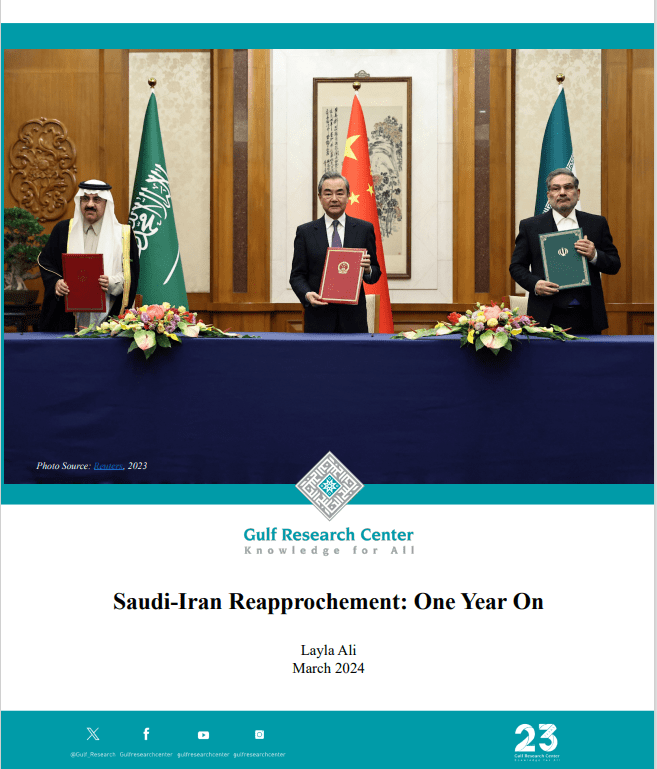
After the restoration of Saudi-Iranian ties one year ago, on March 10, 2023, through the Chinabrokered rapprochement agreement, the region and the international community have now had time to assess the deal's efficacy both on the bilateral relationship and the regional landscape. Notwithstanding divergent goals, the relationship's trajectory indicates that both parties have benefited from the agreement in practice. While the landmark agreement has enhanced stability in the Middle East, the road ahead remains difficult and complex.
The main successes and failures in the relationship between Saudi Arabia and Iran one year after reconciliation can be outlined by drawing on the contents of the joint statement of Saudi Arabia, Iran, and China issued after the first meeting of the trilateral joint committee, which took place in December 2023, between Chinese Foreign Minister Wang Yi, Iranian Deputy Foreign Minister for Political Affairs Ali Bagheri Kani, and Saudi Deputy Foreign Minister Waleed A. Elkhereiji. It states: “During the talks, the two sides stressed the importance of activating and pursuing the implementation of the Beijing Agreement, thus enhancing mutual trust and expanding cooperation, and contributing to realizing security, stability, and prosperity in the region.”
The overall messaging and framing of ties have been positive. Senior officials from Tehran and Riyadh repeatedly express their commitment to making this deal work and prioritizing bilateral relations. Diplomatic consultations have taken place throughout the past year, representing necessary confidence-building measures. On October 11, 2023, Iranian President Ebrahim Raisi and Saudi Crown Prince and Prime Minister Mohammed bin Salman had their first phone conversation in which the two discussed their deep concern for the dire humanitarian situation in Gaza. This was followed by President Raisi's visit to the Kingdom as part of the Organization of Islamic Conference’s (OIC) extraordinary summit on the Gaza crisis, which included Iran’s nonobjection to the final summit communique. Such a visit would have been unthinkable just a couple of years ago. The media coverage of one another has also witnessed some changes. While some negative coverage continues unabated, Iranian media channels have noticeably reduced the severity of their discourse on Saudi Arabia.
From the Kingdom’s perspective, the agreement is seen as a worthwhile and necessary step to addressing areas of mutual interest. There is also a core belief that the restoration of relations has a positive regional and global impact. For example, in the past year, Saudi-Syrian relations have turned a new page with Syria being admitted back into the Arab League following President Bashar Assad’s attendance at the 32nd Arab League Summit in Jeddah in May 2023. With reference to the Gaza conflict, the communication channels between Riyadh and Tehran have been critical to avoiding further regional escalation and to coordinating positions on de-escalation and promoting Palestinian rights. Had the events of October 7 occurred before the Saudi-Iran rapprochement, the reconciliation would most likely never have taken place.
The same assessment also applies to the Islamic Republic. Describing progress between Riyadh and Tehran during his visit to the Saudi capital, the Iranian foreign minister told a joint press conference with his Saudi counterpart, Prince Faisal bin Farhan: “Relations between Tehran and Saudi are on the right track, and we are witnessing progress…the talks were successful.” Prince Faisal bin Farhan stated that the meeting “is a continuation of the steps taken towards implementing the agreement to resume diplomatic relations, which represents a pivotal platform in the history of the two countries and the path of regional security.”
What is further clear is that there have been no missile attacks from Iran or its militias on the Kingdom and direct firings from Yemen or elsewhere in the region have subsided. This suggests that the Iran-Saudi detente has improved the domestic security dynamics for the time being. The agreement has also reduced pressure on the government of the Islamic Republic by lessening its isolation in the region in the face of international scrutiny imposed by sanctions.
Looking Ahead
Still, many divisive issues remain. One main concern for Saudi Arabia is Iran's commitment to non-interference policies with the Kingdom and the wider Arab region. Saudi Arabia continues to emphasize that bilateral discussions should stress "the necessity of non-interference in internal affairs'' and that regional security issues must be part of continued talks. From the Saudi perspective, there remains the need for Tehran to review its regional policies and to clearly show that the Islamic Republic is ready to pursue a more cooperative relationship.
In the context of the war in Gaza, Iran has used the crisis to support its proxies in Yemen and Iraq by manipulating media narratives and appealing to Muslim sentiment. There is great concern that Tehran's behavior and aspirations in the Middle East have been heightened by Hamas's Operation al-Aqsa Flood which are already reflected in increased actions and attacks by those groups supported by Tehran including the Houthi in Yemen, Iraqi Shi'a militias and Lebanon's Hezbollah. In the Red Sea, the dangerous escalation by the Houthi against international shipping has opened a clear escalatory front. In Syria, where Iran is still deeply embedded and where it has not taken any tangible steps to interdict the smuggling of drugs and weapons, the threat even to nearby nations like Jordan could intensify. All of these actions undermine the region’s security and stability.
It must therefore be acknowledged that the agreement has, up to this stage, not fundamentally transformed the strategic calculus of either side. While the room for potential progress to accelerate steps to strengthen cooperation between Tehran and Riyadh in areas such as security, economy, tourism, and transportation exists, much more needs to happen on the regional security front before real tangible cooperation can be implemented. Broader economic ties and mutual investment, for example, can only occur if progress is made on the sanctions regime that remains in place against Iran.
In that context, the role of China could prove essential. As a facilitator to the Saudi-Iran deal, China has so far ensured that both sides remain aligned to achieve mutual interests, encourage positive dialogue, and continue to foster stability. But China has also not been confronted by a crisis in the relationship, and as such its capacity in its role as a 'regional stabilizer' still remains to be seen. While expectations of China’s role both in the region and as part of Saudi-Iran rapprochement should not be exaggerated, overcoming the mutual distrust that persists between Riyadh and Tehran might only be possible by more sustained efforts from Beijing to bridge the fundamental differences that continue to exist. This will include addressing concerns over Iran’s support for proxy forces, Iran’s missile program and the open questions related to Iran’s nuclear program, where China is part of the P5+1 framework overseeing the negotiations.
After one year, the trajectory for Saudi-Iran rapprochement seems to have followed a cautiously optimistic path. While deep-seated mistrust and regional rivalries linger, both countries have shown signs of willingness to engage in dialogue and diplomacy. Several rounds of talks, both bilateral and mediated by third parties, have taken place, indicating a growing recognition of the need for cooperation in addressing regional challenges.The bottom line is that there does exist an overall realization that despite the history of animosity and frayed ties, a new page must be turned if regional stability is to stand a chance.
*Layla Ali is a Researcher at the Gulf Research Center

